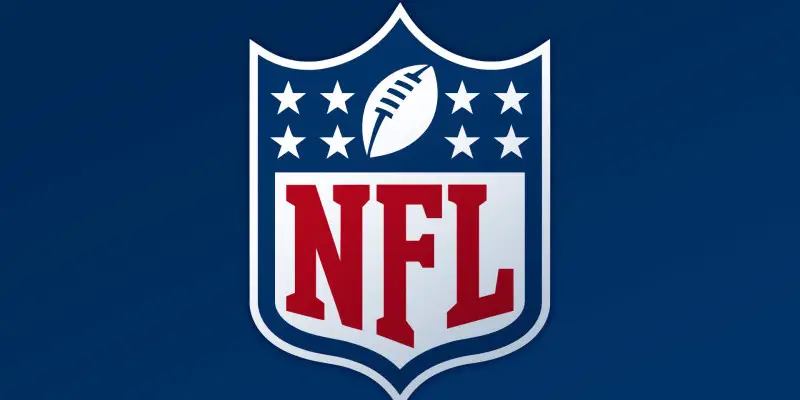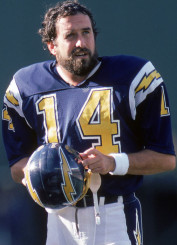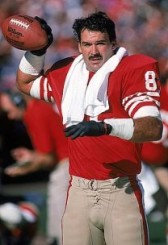Throughout the Oregon Ducks’ football history, they have provided some incredible NFL talent. Despite being criticized as a program that “does not prepare players for an NFL offense,” Oregon has produced some incredible NFL players.
To prove this, I compiled a starting lineup of Ducks throughout history based on their NFL production; do not expect to see Marcus Mariota, Joey Harrington, LaMichael James, or Dennis Dixon on this list.
Here is my starting offensive lineup for Oregon based on NFL production:
Quarterback:
Starting Quarterback: Dan Fouts
Taken by the Chargers 64th overall, Fouts was a franchise quarterback for 14 years of his career, all with San Diego. In that time, Fouts managed to record some feats for the record books. He was selected for the Pro Bowl six times in his career. Fouts was also the first player to ever reach 4,000 passing yards three seasons in a row (1979-1981). Fouts was elected to the Pro Football Hall of Fame in 1993, one of six Ducks to gain such an honor. In his career, Fouts managed a 254/242 touchdown/interception ratio, and posted a total of 43,040 total career passing yards.
Backup Quarterback: Norm Van Brocklin
Van Brocklin was drafted by the LA Rams in 1949 draft 37th overall (which, back then, was the fourth round). There were only 10 teams back then, so there were 25 rounds to compensate every position. Van Brocklin served as a fairly active second-string to Bob Waterfield, during which the Rams won the 1951 NFL championship.
The two often split time, with Waterfield taking the larger percentage of the snaps. After a brief “retirement”, Brocklin returned to the NFL with the Philadelphia Eagles. (An Oregon Duck playing for Philly? Sounds ridiculous.) Van Brocklin led Philly to an NFL title in 1960. His statistics are not as flashy, but it is important to keep in mind that back then, NFL teams only played 12 games. He sported 23,611 passing yards and 173 touchdowns in his career, as well as 11 rushing touchdowns.
Running Back
Starting Running Back: Jonathan Stewart
It was a hard decision between Stewart and Blount; both have had very different careers. Stewart was given a more stable situation when he was drafted, taken 13th in the 2008 draft by the Carolina Panthers, with the intention of splitting time with Deangelo Williams.
The two served as one hell of a dynamic duo, both earning more than 1,100 yards in 2009, the first time in NFL history. Stewart also had 10 touchdowns in both his rookie and sophomore seasons. He holds the Panthers’ rookie rushing record (836) and the franchise single game rushing record (206).
So, why not Stewart? Well, that answer comes in 2010, when Stewart was granted the starting job over Williams, who was placed on IR. Stewart managed only two touchdowns throughout the entire season, accumulating a measly 770 rushing yards.
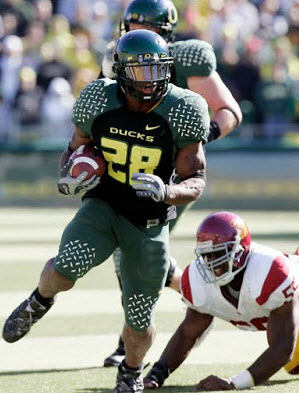
Jonathan Stewart
Stewart then had a three-year run from 2011-2013 in which he was constantly dealing with lingering injuries, managing only five touchdowns in that time. In those years, he posted abysmal rushing numbers of 761, (’11), 336 (’12), and 180(’13), something he previously would accomplish in half a season. In some regards, Stewart can be thought of as a perfect split-time back. Stewart has totaled 4825 yards and 30 rushing touchdowns in his time in the NFL so far, with 1084 receiving yards and five touchdowns.
Back up Running Back: LaGarrette Blount:
The hot-tempered journeyman, Blount has played for the Titans, Buccaneers, Patriots, Steelers, and Patriots. His career has hit the lowest of the lows, after being not drafted due to off the field issues. At Tennessee, he was cut for getting into a fight with defensive end Eric Bakhitari.
While with the Steelers, Blount was not given any snaps during a game against the Titans. He walked out of the game early, which incidentally led to him being released.
He has also seen the highest of the highs, winning a Super Bowl with the New England Patriots, and setting a franchise record for all-purpose yards with 334 yards. In four years in the NFL, Blount has accumulated 3258 yards and 25 touchdowns. Not bad, considering he only started one full season.
Fullback: Alfonse “Tuffy” Leemans
I know what you’re thinking; “Oregon has a fullback in the NFL”? Well, once upon a time, the fullback was not only a position used for blocking. For one year, 1934, Tuffy started for Oregon’s football team before transferring to George Washington University. Hey, I’ll count it.
Tuffy was selected 18th overall in the 1936 draft by the New York Giants. In his first year, Tuffy lead the league in rushing yards with 830 (it was a different time). Tuffy spent his entire eight-year NFL career with the Giants, racking up 3132 yards and 17 touchdowns. When is the last time you saw a fullback with those numbers? The Giants won the 1938 NFL championship, and Leemans was elected to the Pro Football Hall of Fame in 1978.
Offensive Tackles:
Gary Zimmerman
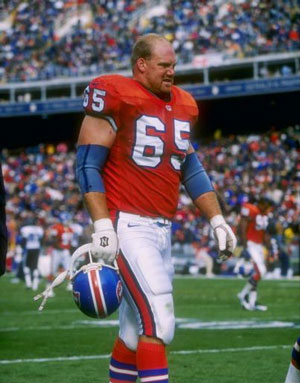
Zimmerman was a dominant offensive linemen that helped Elway win his first and only Superbowl.
Zimmerman has by far the most impressive resume of any offensive tackle or guard to come out of Oregon (in terms of NFL production) — ironic in that he started his career with the LA Express, a team in the now-defunct USFL.
Zimmerman was selected in the first round of the 1984 supplemental draft by the Express, but signed to the Vikings when the UFSL was cancelled. Zimmerman was elected to the Pro Bowl 7 times, 5 of which were first-team selections. He was also elected to the NFL’s all decade team for the ’80s and ’90s. Zimmerman was also a key player in the Bronco’s Super Bowl run with John Elway. In his 12-year career in the NFL, Zimmerman never missed a game.
Adam Snyder:
Listed as a guard/tackle in the NFL, Synder was taken 94th overall in the 2005 draft by San Fransisco. He had a strong 7-year stint with the 49ers, before being signed to Arizona – San Fransisco again – until finally landing with the Giants. Despite only playing one game due to a knee injury, Snyder is expected to be a big contributor to a struggling Giants offensive line next season.
Offensive Guards:
Geoff Schwartz:
A star lineman while at Oregon, Schwartz has had a journeymen-style career. He began his career at Carolina after being taken 241st overall in the 2008 draft. Schwartz helped fellow Oregon alumni and fellow list qualifier Jonathan Stewart achieve his 1,100-yard season. Schwartz then signed with the Vikings in 2012, and helped Adrian Peterson rush for more than 2,000 yards. After a year with the Chiefs in 2013, Schwartz landed with the New York Giants, signed a $16.8 million deal.
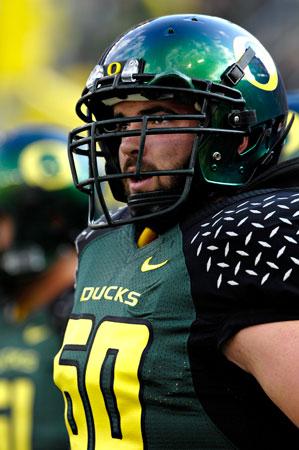
Max Unger
Andy Maurer:
The Atlanta Falcons selected Maurer in the 1970 draft 64th overall. Like Schwartz, Maurer had a journeymen career. After three years with the Falcons, he went on to play for the Saints, Vikings, 49ers and Broncos. Despite moving so often during his 7-year career, Maurer was more often than not an instant starter. He started 84 out of 109 games in his career. He also played in two Super Bowls — one with the Vikings, and once again with the Broncos.
Center
Starting center: Fred Quillan:
A two-time pro bowl center, Quillan was selected by the 49ers in the 1978 draft 175th overall, where he spent his entire career. Quillan was responsible for leading the offensive line that protected legendary quarterback, Joe Montana. With the 49ers, Quillan won two Super Bowls, and started 129 out of 143 games.
Backup: Max Unger:
Selected in the 2009 draft 29th overall by the Seahawks, Unger has established himself as one of the most consistent centers in the NFL today. The 2-time Pro-Bowler and Super Bowl champion has yet to miss a game. Unger was just involved in a shocking trade as he was sent to the New Orleans Saints along with a 1st-round draft pick in exchange for Tight End Jimmy Graham. Some would say the Seahawks won that trade, but we will see how the ‘Hawks manage to replace such an incredible center.
Tight End:
Starting Tight End: Russ Francis
Selected in the NFL Draft 16th-overall by the New England Patriots, the 3-time Pro Bowler had a lengthy career in the NFL. The Seattle native spent 6 years with the Patriots, 5 years with the 49ers, and then 2 more years with the Patriots. Francis amassed 5262 yards and 40 touchdowns over a 13-year career, and won a Super Bowl with the 49ers and Joe Montana.
Backup Tight End: Ed Dickson
“Dixon to Dickson”! Who else remembers that passing combination? The Baltimore Ravens selected Ed Dickson with 70th-overall pick in the 2010 NFL draft. While his numbers are not the flashiest, Dickson had a successful 4-year career with the Ravens, with which he won a Super Bowl.
Dickson is now on the Carolina Panthers roster. So far, he has amassed 1293 yards and 8 touchdowns. Granted, 5 of those touchdowns were in one season.
Wide Receiver:
Starting Wide Receiver: Ahmad Rashad (aka Bobby Moore)
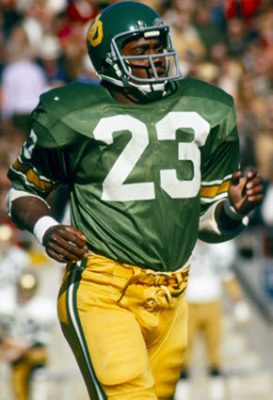
Bobby Moore 1972
This one was not even a contest. Rashad is a former college running back turned pro receiver, who has had a hall-of-fame caliber career. Rashad was drafted 4th overall by the St. Louis Rams in the 1972 draft, but was traded the next year to the Buffalo Bills, to back up OJ Simpson.
Rashad finally found his home in Minnesota, where he spent 7 years playing for the Vikings. In his time there, he was selected for the Pro Bowl 3 out of 7 years. Rashad had 495 receptions for 6831 receiving yards and 44 touchdowns.
Slot receiver: J.J. Birden
The Portland native was selected 216th-overall by the Cleveland Browns in the 1988 draft. Birden spent two years on the Browns’ practice squad, before getting signed to the Cowboys’ practice squad.
Birden got his break when he signed with the Kansas City Chiefs. Despite not starting for the first two years of his time with the Chiefs, he caught 42 passes good for 5 touchdowns over that span.
Birden stayed with the Chiefs until 1995, when he signed with Atlanta, where he spent the final two years of his career. He had 244 receptions over his career good for 3441 yards and 17 touchdowns.
Stay tuned for part 2: Defense.
Related Articles:
Daniel “Kantor” Kantor is a soon-to-be graduating 5th year senior at the University of Oregon majoring in advertising with a double minor in business and music. He hails from Southern California and grew up in a UCLA family, where he learned from a very young age to despise the USC Trojans. He switched to the green side when he committed to attend the U of O and witnessed his first ever Duck game: Oregon: 72, New Mexico: 0. That season turned into the magical roller coaster that was the year of the 2011 BCS National Championship against Auburn (I will argue to the death that he was down).
Aside from rooting for the Ducks, you can find Daniel rooting for the Los Angeles Lakers, New York Giants, Dodgers, and the 6th grade Eugene basketball tem he coaches. I also have a husky as a pet, but she’s definitely a husky fan. Daniel plans to move to Portland after graduation to pursue a job in media.

